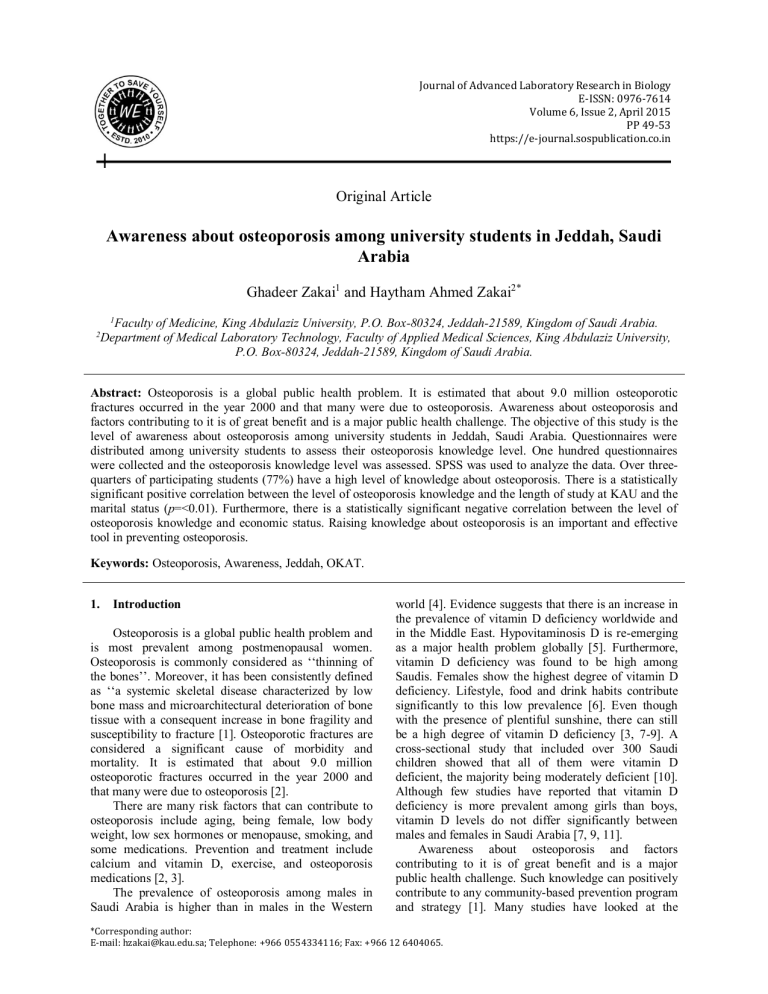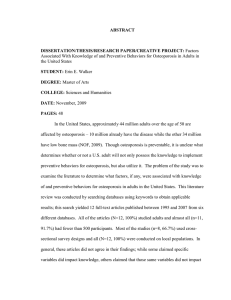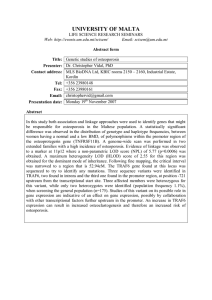Awareness about osteoporosis among university students in Jeddah, Saudi Arabia

Journal of Advanced Laboratory Research in Biology
E-ISSN: 0976-7614
Volume 6, Issue 2, April 2015
PP 49-53 https://e-journal.sospublication.co.in
Original Article
Awareness about osteoporosis among university students in Jeddah, Saudi
Arabia
Ghadeer Zakai
1
and Haytham Ahmed Zakai
2*
1 Faculty of Medicine, King Abdulaziz University, P.O. Box-80324, Jeddah-21589, Kingdom of Saudi Arabia.
2 Department of Medical Laboratory Technology, Faculty of Applied Medical Sciences, King Abdulaziz University,
P.O. Box-80324, Jeddah-21589, Kingdom of Saudi Arabia.
Abstract: Osteoporosis is a global public health problem. It is estimated that about 9.0 million osteoporotic fractures occurred in the year 2000 and that many were due to osteoporosis. Awareness about osteoporosis and factors contributing to it is of great benefit and is a major public health challenge. The objective of this study is the level of awareness about osteoporosis among university students in Jeddah, Saudi Arabia. Questionnaires were distributed among university students to assess their osteoporosis knowledge level. One hundred questionnaires were collected and the osteoporosis knowledge level was assessed. SPSS was used to analyze the data. Over threequarters of participating students (77%) have a high level of knowledge about osteoporosis. There is a statistically significant positive correlation between the level of osteoporosis knowledge and the length of study at KAU and the marital status (p=<0.01). Furthermore, there is a statistically significant negative correlation between the level of osteoporosis knowledge and economic status. Raising knowledge about osteoporosis is an important and effective tool in preventing osteoporosis.
Keywords: Osteoporosis, Awareness, Jeddah, OKAT.
1.
Introduction
Osteoporosis is a global public health problem and is most prevalent among postmenopausal women.
Osteoporosis is commonly consid ered as ‘‘thinning of the bones
’’. Moreover, it has been consistently defined as ‘‘a systemic skeletal disease characterized by low bone mass and microarchitectural deterioration of bone tissue with a consequent increase in bone fragility and susceptibility to fracture [1]. Osteoporotic fractures are considered a significant cause of morbidity and mortality. It is estimated that about 9.0 million osteoporotic fractures occurred in the year 2000 and that many were due to osteoporosis [2].
There are many risk factors that can contribute to osteoporosis include aging, being female, low body weight, low sex hormones or menopause, smoking, and some medications. Prevention and treatment include calcium and vitamin D, exercise, and osteoporosis medications [2, 3].
The prevalence of osteoporosis among males in
Saudi Arabia is higher than in males in the Western world [4]. Evidence suggests that there is an increase in the prevalence of vitamin D deficiency worldwide and in the Middle East. Hypovitaminosis D is re-emerging as a major health problem globally [5]. Furthermore, vitamin D deficiency was found to be high among
Saudis. Females show the highest degree of vitamin D deficiency. Lifestyle, food and drink habits contribute significantly to this low prevalence [6]. Even though with the presence of plentiful sunshine, there can still be a high degree of vitamin D deficiency [3, 7-9]. A cross-sectional study that included over 300 Saudi children showed that all of them were vitamin D deficient, the majority being moderately deficient [10].
Although few studies have reported that vitamin D deficiency is more prevalent among girls than boys, vitamin D levels do not differ significantly between males and females in Saudi Arabia [7, 9, 11].
Awareness about osteoporosis and factors contributing to it is of great benefit and is a major public health challenge. Such knowledge can positively contribute to any community-based prevention program and strategy [1]. Many studies have looked at the
*Corresponding author:
E-mail: hzakai@kau.edu.sa; Telephone: +966 0554334116; Fax: +966 12 6404065.
Awareness about osteoporosis Zakai and Zakai knowledge and awareness about osteoporosis and its risk factors in the world and reported a low degree of knowledge and awareness [12-19]. However, the lack of studies about such knowledge in Saudi Arabia is a major obstacle in setting awareness campaigns. In this study, we looked at the level of awareness about osteoporosis among university students in Jeddah,
Saudi Arabia.
2.
Materials and Methods
One hundred and forty-four questionnaires assess osteoporosis knowledge were randomly distributed among female students at King Abdulaziz University,
Jeddah, Saudi Arabia between the periods January to
May 2014. After excluding students who were diagnosed as osteoporotic or who were studying in health specialties, 100 questionnaires were collected.
The osteoporosis knowledge assessment tool
(OKAT) questionnaire was adopted from Winzenberg
et al., [20] and was translated into Arabic language. The questionnaire included 14 true and false questions about osteoporosis and one mark was given to each question answered correctly (Table 1). In addition, demographic data, including Age, specialty, length of study at the
University, marital status, presence of relatives in health specialties and economic status were included.
Level of knowledge and level of newsgathering were also estimated through several questions. Data were analyzed using SPSS (Ver. 16).
Table 1. OKAT questions used to measure the level of awareness about osteoporosis.
1. Osteoporosis leads to an increased risk of bone fractures.
2. Having a higher peak bone mass, at the end of childhood gives no protection against the development of osteoporosis in later life.
3. Osteoporosis usually causes symptoms (e.g., pain) before fractures occur.
4. Cigarette smoking can contribute to osteoporosis.
5. A fall is just as important as low bone strength in causing fractures.
6. Any type of physical activity is beneficial for osteoporosis.
7. Family history of osteoporosis strongly predisposes a person to osteoporosis.
8. An adequate calcium intake can be achieved from two glasses of milk a day.
9. Sardines and broccoli are good sources of calcium for people who cannot take dairy products.
10. There is a small amount of bone loss in the ten years following the onset of menopause.
11. Hormone therapy prevents further bone loss at any age after menopause.
12. There are no effective treatments for osteoporosis available.
13. Alcoholism is a predisposing factor to osteoporosis.
14. Osteoporosis is considered a silent disease.
15. High dairy intake can prevent osteoporosis.
3.
Results
One hundred answered questionnaires to assess osteoporosis knowledge were collected among female
J. Adv. Lab. Res. Biol. students at King Abdulaziz University, Jeddah, Saudi
Arabia as described previously.
Most of the student's ages ranged from 18-23 years and the majority were studying Art & Humanities
(28%) as shown in Figs. 1 & 2. Most of the participants were during their second year of study (Fig. 3). Almost four-fifths of students were single and had no relatives in the health field (Figs. 4 & 5) and about half of them fall within the average economic status (Fig. 6). In terms of having a zealous nature towards obtaining news and information and cultural knowledge, the majority of students were below average (45%) even though 91% of them depended on up to five sources to retrieve such information and knowledge (Figs. 7 & 8).
2
21
12
39
Less than 18
5
18-20 years
Fig. 1. Ages of participating students.
14 16
4
21-23 years
1 2 3 4 5 6
Fig. 3. Level of participating students.
Over 23 years
28
38
25
Economy & Administration
Science
Home Economics
Islamic Studies, Art & Humanities
Engeneering
PreYearparatory
Fig. 2. Colleges of participating students.
5
0 1
2
3
50
Awareness about osteoporosis
19
2
79
Single Married Divorced
Fig. 4. Marital status of participating students.
23
Zakai and Zakai
After calculating the osteoporosis knowledge level according to the osteoporosis knowledge assessment tool, 77% of students had high OKAT scores (Fig. 9).
There is a statistically significant positive correlation between the level of osteoporosis knowledge and the length of study at KAU and the marital status (p=<0.01). Furthermore, there is a statistically significant negative correlation between the level of osteoporosis knowledge and economic status.
9
47
44
0-2 sources 3-5 sources Over 5 sources
Fig. 8. Number of sources to retrieve information and knowledge.
77
35
Yes No
Fig. 5. Presence of a relative in the health field.
15
48
Below Average Average Above average
Fig. 6. Economic status of participating students.
20
37
45
Below average Average Above average
Fig. 7. Having a nature towards obtaining news, information and cultural knowledge.
90
80
70
60
50
40
30
20
10
0
0
23
77
Low Medium High
Fig. 9. Level of knowledge about osteoporosis.
4.
Discussion
This study investigated the level of awareness about osteoporosis among university students in
Jeddah, Saudi Arabia as described above. A questionnaire was distributed among university students and it included questions to assess the level of knowledge about osteoporosis, according to the osteoporosis knowledge assessment tool (OKAT) in addition to demographic data [20].
Osteoporosis is considered a global public health problem and is most prevalent among postmenopausal women. University students are considered as the youngest part of any community. Therefore, knowing about osteoporosis among university students will help in adopting living and nutritional standards that will help to avoid such bone thinning disease. Furthermore, university students who have good knowledge about
J. Adv. Lab. Res. Biol. 51
Awareness about osteoporosis Zakai and Zakai osteoporosis are key factors in raising community awareness about this disease.
More than three-quarters of university students showed a high osteoporosis knowledge level. King
Abdulaziz University started an osteoporosis awareness and prevention campaign through the Center of
Excellence for Osteoporosis. This campaign in its primary launch aimed at raising the knowledge about osteoporosis among KAU students at first and transferring this knowledge to the rest of the community through students and their families. In this study, there is a statistically significant positive correlation between the level of osteoporosis knowledge and the length of study at KAU. This means that the osteoporosis awareness and prevention campaign at KAU reached a high percentage of students, especially those spent more time at the university.
Married students were more knowledgeable about osteoporosis than single students. It is well known that married individuals are more careful regarding osteoporosis, especially that newlywed couples care more about their bone health, calcium and vitamin D intake in preparation for conceiving a child.
On the other hand, this study revealed that students who fall in the low economic status level have a better knowledge of osteoporosis. This may be explained by the fact that such students spend more time in reading about such issues since their economic status does not allow them to spend time having fun.
Continuing the osteoporosis awareness campaign is therefore considered an important tool in raising awareness and knowledge about osteoporosis.
Furthermore, extending the campaign to high school students and other individuals in the community will facilitate the transfer of knowledge about osteoporosis and hence will reduce the prevalence of such disease.
Educational programs are needed to improve awareness and motivating healthy behaviors to avoid osteoporosis.
Moreover, media and electronic information media should be used to help in raising knowledge about osteoporosis.
As a conclusion, raising the knowledge about osteoporosis is an important and effective tool in preventing osteoporosis.
References
[1].
Shakil, A., Gimpel, N.E., Rizvi, H., Siddiqui, Z.,
Ohagi, E., Billmeier, T.M. and Foster, B. (2010).
Awareness and prevention of osteoporosis among
South Asian women. Journal of Community
Health, 35: 392-397.
[2].
Johnell, O. and Kanis, J.A. (2006). An estimate of the worldwide prevalence and disability associated with osteoporotic fractures.
Osteoporosis International, 17: 1726-1733.
[3].
Ardawi, M.S.M., Sibiany, A.M., Bakhsh, T.M.,
Qari, M.H. and Maimani, A.A. (2012). High prevalence of vitamin D deficiency among
J. Adv. Lab. Res. Biol. healthy Saudi Arabian men: relationship to bone mineral density, parathyroid hormone, bone turnover markers, and lifestyle factors.
Osteoporosis International, 23: 675-686.
[4].
Sadat-Ali, M. and AlElq, A. (2006). Osteoporosis among male Saudi Arabs: a pilot study. Annals of
Saudi Medicine, 26(6): 450-454.
[5].
Mithal, A., Wahl, D.A., Bonjour, J.P., Burckhardt,
P., Dawson-Hughes, B., Eisman, J.A., El-Hajj
Fuleihan, G., Josse, R.G., Lips, P., Morales-
Torres, J., IOF Committee of Scientific Advisors
(CSA) Nutrition Working Group (2009). Global vitamin D status and determinants of
Hypovitaminosis D. Osteoporosis International,
20: 1807-1820.
[6].
Elshafie, D.E., Al-Khashan, H.I. and Mishriky,
A.M. (2012). Comparison of vitamin D deficiency in Saudi married couples. European Journal of
Clinical Nutrition, 66: 742-745.
[7].
Kensarah, O.A. and Azzeh, F.S. (2012). Vitamin
D Status of Healthy School Children from
Western Saudi Arabia. Pakistan Journal of
Nutrition, 11(3): 288-292.
[8].
Agens, J.E., Galasko, G.T., Purandare, A.V. and
Lin, J. (2002). Awareness of vitamin D deficiency states and recommended supplementation doses:
Survey of faculty and staff at a medical school. e-
SPEN Journal, 7: e215-e218.
[9].
Elsammak, M.Y., Al-Wossaibi, A.A., Al-
Howeish, A. and Alsaeed, J. (2011). High prevalence of vitamin D deficiency in the sunny
Eastern region of Saudi Arabia: a hospital-based study. East Mediterranean Health Journal, 17(4):
317-322.
[10].
Al-Othman, A., Al-Musharaf, S., Al-Daghri,
N.M., Krishnaswamy, S., Yusuf, D.S., Alkharfy,
K.M., Al-Saleh, Y., Al-Attas, O.S., Alokail, M.S.,
Moharram, O., Sabico, S. and Chrousos, G.P.
(2012). Effect of physical activity and sun exposure on vitamin D status of Saudi children and adolescents. BMC Pediatrics, 12, 92.
[11].
Al-Ghamdi, M.A., Lanham-New, S.A. and Kahn,
J.A. (2012). Differences in vitamin D status and calcium metabolism in Saudi Arabian boys and girls aged 6 to 18 years: effects of age, gender, extent of veiling and physical activity with concomitant implications for bone health. Public
Health Nutrition, 15(10): 1845-1853.
[12].
Ford, M.A., Bass, M.A., Keathley, R. (2007).
Osteoporosis Knowledge and Attitudes: A Cross-
Sectional Study among College-Age Students.
Journal of American College of Health, 56: 43-47.
[13].
Gemalmaz, A. and Oge, A. (2008). Knowledge and awareness about osteoporosis and its related factors among rural Turkish women. Clinical
Rheumatology, 27: 723-728.
[14].
Kim, K.H., Lee, K., Ko, Y.J., Kim, S.J., Oh, S.I.,
Durrance, D.Y., Yoo, D., Park, S.M. (2012).
Prevalence, awareness, and treatment of osteoporosis among Korean women: The Fourth
52
Awareness about osteoporosis
Korea National Health and Nutrition Examination
Survey. Bone, 50: 1039-1047.
[15].
Barzanji, A.T., Alamri, F.A. and Mohamed, A.G.
(2013). Osteoporosis: A study of knowledge, attitude and practice among adults in Riyadh,
Saudi Arabia. Journal of Community Health, 38
(6): 1098-1105.
[16].
Shawa, H., Favela, E. and Diaz, J. (2011).
Knowledge of osteoporosis among men in the primary care setting. Southern Medical Journal,
104(8): 584-588.
[17].
von Hurst, P.R. and Wham, C.A. (2007).
Attitudes and knowledge about osteoporosis risk prevention: A survey of New Zealand women.
Public Health Nutrition, 10(7): 747-753.
[18].
Al Attia, H.M., Abu Merhi, A.A. and Al Farhan,
M.M. (2008). How much do the Arab females
Zakai and Zakai know about osteoporosis? The scope and the sources of knowledge. Clinical Rheumatology, 27
(9): 1167-1170.
[19].
Yu, S. and Huang, Y.C. (2003). Knowledge of, attitudes toward, and activity to prevent osteoporosis among middle-aged and elderly
[20].
women. The Journal of Nursing Research, 11(1):
65-72.
Winzenberg, T.M., Oldenburg, B., Frendin, S. and
Jones, G. (2003). The design of a valid and reliable questionnaire to measure osteoporosis knowledge in women: the Osteoporosis
Knowledge Assessment Tool (OKAT). BMC
Musculoskeletal Disorders, 4: 17. doi:
10.1186/1471-2474-4-17
J. Adv. Lab. Res. Biol. 53


